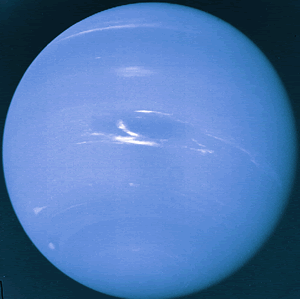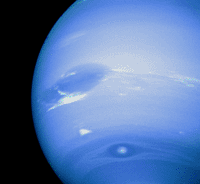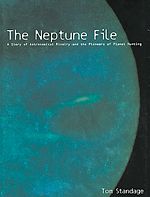






Editor: Kris Cerone
Hunting Worlds Unseen
By Craig E. Ward
Recently, astronomers announced the discovery of a new planet, one at a greater distance than any previously discovered.† A great event in astronomy, but not one that just happened overnight. The techniques used were directly related to techniques pioneered in the 19th Century by astronomers and mathematicians.
As the 18th Century ended and the 19th began, astronomers were presented with a vexing problem. The orbit of the recently (1781) discovered planet Uranus would not stay put. Tom Standage, in The Neptune File, tells the story of how astronomers and mathematicians tackled the problem.
 |
| NASA image of the planet Neptune. |
The problem was that the observed orbit of Uranus kept disagreeing with the calculated orbit. Only by limiting the calculation to a relatively short time period, could the calculation match the observed orbit.
Although William Herschel is credited with the discovery, it turns out that earlier star catalogs recorded the planet without their authors realizing it. By assuming "errors" in the early sightings and discarding them, new calculations could be created that predicted things much more accurately. For a while, that is.
The inability of the tried-and-true methods to predict the orbit generated enough concern that international efforts began solve the mystery.
The effort involved a large cast of characters, but the clear heroes were British mathematician John Couch Adams and French astronomer Urbain Jean-Joseph Le Verrier. Each, working separately, had the key insight that the mismatch had to be because of an undiscovered planet. Using mathematics (in the days before the digital computer) each calculated the expected orbit and location of the unseen planet and asked the astronomers of the world to look for it.
 |
| NASA image of the planet Neptune. |
The German astronomer Johan Gottfried Galle found the planet soon after he started looking.
As often happens in these affairs, this success entered a world of controversy. The British Astronomer Royal, George Airy, had not passed along the work of Adams in a way likely to aid the international scientific community. By accident or intent, Airy gave James Challis, the astronomer in Airy's former post at the Cambridge Observatory, a running start at the search. (Indeed, Challis did see the planet first, but did not know it until after reviewing his observation records.)
When the news of Adams work did get out, it created ill will between the astronomers of France and Britain, with the notable exception of Adams and Le Verrier themselves, who maintained a friendship for the rest of their lives.
 |
| Cover of The Neptune File. |
All was finally resolved and astronomers went about their business again, using the same techniques to find Pluto and several asteroid bodies. When rings were discovered around Neptune, two of them were named after Le Verrier and Adams. (But none for Airy and Challis.)
Standage does a wonderful job of fleshing out this cast of characters and illustrating the very human activity of scientific advancement.
As an epilog to the story, Standage shows how the techniques used by these 19th Century astronomers are the spring boards for the techniques that 20th, and now 21st, century astronomers are using to search for extra-solar planets. The headlines of today are inextricably bound to the headlines of yesterday. The hunt continues.
The Neptune File: A Story of Astronomical Rivalry and the Pioneers of Planet Hunting. Tom Standage. Walker & Company, New York. 2000. ISBN 0-8027-1363-7
† "Way-Out World: New Technique Finds Most Distant Planet Ever," Robert Roy Britt, space.com, January 6, 2003.
Copyright © 1998-2003 Organization for the Advancement of Space Industrialization and Settlement. All Rights Reserved.